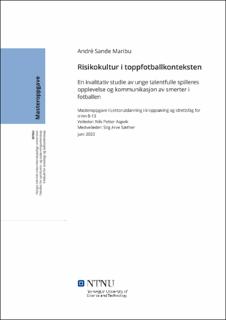| dc.description.abstract | Hensikten med denne studien var å undersøke unge lovende spilleres opplevelser og erfaringer knyttet til den potensielle risikokulturen som finner sted i toppfotballkonteksten. Studien belyser hvordan normalisering av smerter, kommunikasjon av smerter, generelle forventninger og holdninger og belastningsskader som konsekvens spiller inn i utøvernes idealer, tanker, valg og væremåter.
Studien er designet som en kvalitativ abduktiv studie, kontekstualisert i spillerutviklingssystemet i norsk juniorfotball. Utvalget består av seks informanter fra et av toppakademiene i en norsk eliteserieklubb, hvor datamaterialet ble samlet inn fra seks dybdeintervjuer. Dataene ble analysert ved hjelp av både empirinær koding og kategorisering. I tillegg er det benyttet perspektiver fra Michel Foucault og Erving Goffman som en fortolkningsramme i analysearbeidet.
Resultatene viser at samtlige spillere drar/har dratt på trening/kamp med smerter både i akademiet og i tidligere klubber. Kamper prioriteres høyere enn treningsøkter hvor utøverne har en tendens til å justere smerteterskelen. Funnen viser også at relasjon til trener/trenerapparatet har betydning for hva utøverne velger å kommunisere. I tillegg viser resultatene at lagkamerater kan påvirke risikofylt atferd.
Videre påpekes det av utøverne at de ønsker å fremstå som pliktoppfyllende og med en evne til å håndtere en høy treningsbelastning for å ivareta rollen som talentfull. Utøverne vegrer seg til tider for å si ifra om treningssituasjonen deres, og forsøker i stor grad å skjule diskrediterende trekk som smerter. Dette skyldes blant annet lysten til å spille og vise seg frem, og frykten for begrenset spilletid. Det viser seg også at utøverne vier ekstremt stor tillit til treneren og trenerapparatet. Spillerne stiller seg derfor ofte ukritiske og godtar praksisen, også der hvor den står i strid med deres egne idealer og væremåter. Det understrekes derfor at tillit og trygget mellom trener-utøver er en viktig del av arbeidet for å dempe virkningene av risikokulturen.
Til sist peker ikke funnene i en klar retning når det kommer til belastningsskader som konsekvens. Utøverne er klar over de potensielle konsekvensene av valgene de gjør. Likevel har samtlige utøvere en forståelse av at belastningsskader er en del av toppidretten, hvor mye omhandler tilfeldigheter og flaks. | |
| dc.description.abstract | The aim of this study was to examine youth promising players and their experiences linked to the risk culture within the context of top football. This study illuminates how normalization of playing through injury and pain, communication of pain, general expectations and attitudes and overuse injuries as a consequence, play a part in the athlete’s ideals, thoughts, choices and ways of being.
This study is designed as a qualitative abductive study, contextualized within the player development system in Norwegian junior football. The sample consists of six players from a top academy in one of the major clubs in the Norwegian top division, whereas the data is gathered from six depths-interviews. The data were analysed using both empirical coding and categorization. In addition, perspectives from Michel Foucault and Erving Goffman have been used as an interpretive framework in the analysis work.
The results reveal that all the players go/have gone to training/matches with pain, both in the academy and in previous clubs. Matches are given higher priority than training sessions where athletes tend to adjust the pain threshold. The findings also show that the relationship with the coach/coaching staff is important for what the athletes choose to communicate. In addition, the results show that teammates can influence risky behaviour.
Furthermore, it is pointed out by the players that they want to appear as conscientious and with an ability to handle a high training load to fulfil the role as talented. They sometimes avoid talking about their training situation, and largely try to hide discrediting features such as pain, because of the desire to play and show off, and the fear of limited playtime. It also turns out that the athletes place extremely great trust in the coach and the coaching staff. This leads to players often being uncritical and accepting the practice, even where it is contrary to their own ideals and beliefs. It is therefore emphasized that trust between the coach and the players is an important part of the work to mitigate the effects of the risk culture.
Finally, the findings do not point in a clear direction when it comes to overuse injuries as a consequence. The players are aware of the potential risk and consequences of the choices they make. Nevertheless, all athletes have an understanding that overuse injuries are a part of top sports, where factors like coincidence and luck is being highlighted. | |
